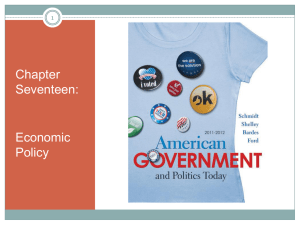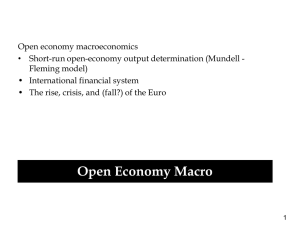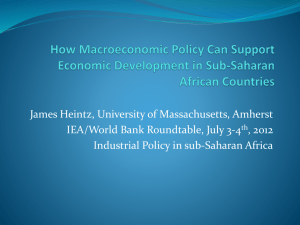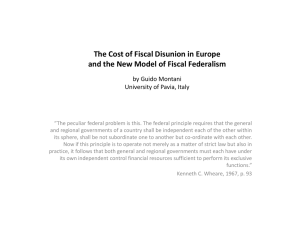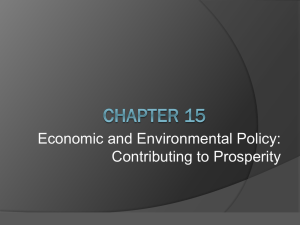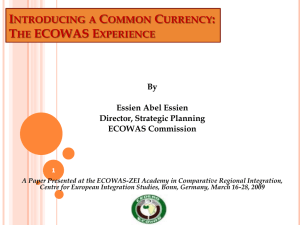East Africa Monitory Union Protocal
advertisement
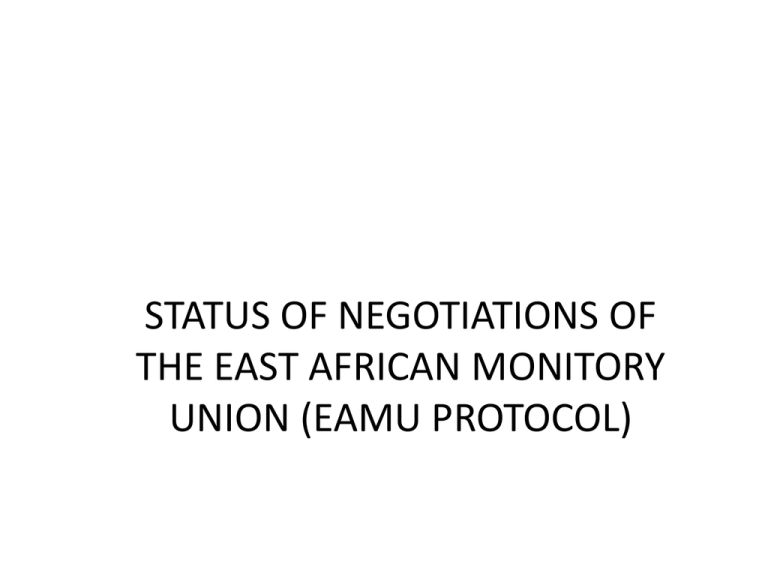
STATUS OF NEGOTIATIONS OF THE EAST AFRICAN MONITORY UNION (EAMU PROTOCOL) Plan of presentation • • • • • Background Current status of EAMU preparations Creation of a legal framework for EAMU Salient Issues Conclusion I- Background • EAC integration is guided by Treaty that came into effect in 2000 and provides for the following stages of integration process as Customs Union, Common Market, Monetary Union, Political federation • Customs Union started in 2005 in a progressive approach up to 2010 when EAC entered into a fully fledged Customs Union. Currently process of having the EAC as a single Customs territory with a single customs authority is in advanced stages • Common Market Protocol came into force in July 2010 and will be implemented in a progressive approach until 2015. • When fully implemented the four freedoms will be realised including movement of people and capital which are critical for Monetary Union among others. • Process of establishing the EAMU is in progress in line with the Summit directive of establishing the EAMU by 2012. • Scope of cooperation: To put in place a common central bank (to manage the common monetary policy) and a single currency. II- Current status on EAMU preparations • Preparatory works is ongoing which include: Harmonisation of Monetary and exchange rate Policies through Monetary Affairs Committee (MAC) Harmonisation of fiscal policies through the Committee on Fiscal Affairs (CFA) Harmonisation of Statistics through the Committee on Statistics Harmonisation of financial sector through the Capital Markets, Insurance and Pensions Committee (CMIPC) • The MAC has made substantial work in among others creating frameworks for harmonisation of: Monetary Exchange rate policies Payment and settlement system (EAPS) Banking supervision Information communication technology Financial markets Accounting and Finance • The Committee on Fiscal Affairs has made significant progress in: Excise Tax harmonisation Value Added Tax harmonisation Conclusion of Double taxation Agreement Budget process coordination at regional level through pre-budget and post-budget consultative meetings which results into regional coordination of economic policies. • The Committee on Statistics in collaboration with institutions such as the Central banks has initiated programs in harmonisation of economic statistics with emphasis on: Monetary and Financial Statistics Financial Soundness indicators Harmonised Consumer Price Index Government Finance statistics Balance of payments Statistics National Accounts • The Capital Markets, Insurance and Pension Committee (CMIPC) is making remarkable progress on financial markets integration through regionalising of the Capital Markets, Insurance and Pensions sectors. Financial Markets Integration as a prerequisite for the EAMU is progressing through the creation of a single financial market in the region which is being implemented through the Financial Sector Development and Regionalization Project (FSDRP) in collaboration with the World Bank. The creation of a single financial market will facilitate free movement of capital, financial services, goods and labour in the region. • The single financial market will among others be achieved through: Financial Inclusion and Strengthening of Market Participants Harmonization of Financial Laws and Regulations Mutual Recognition of Supervisory Agencies Integration of Financial Market Infrastructure Development of the Regional Bond Market Capacity building of key players III- Creation of a legal framework for EAMU • Currently the process of negotiation of a EAMU Protocol is ongoing by a multidisciplinary team of senior government experts (High Level Task Force: HLTF) • The Protocol will provide a legal and regulatory framework for the operation of the EAMU. • The negotiations started in January, 2011 in Arusha • Seven round of negotiation have since been held. • On a operational point of view, HLTF is composed of technical working groups: macroeconomic policies, statistics, financial matters and Payment & Settlement Systems; • In addition Protocol will have a roadmap for transitional arrangements • The issues under negotiations among others include: Objectives and scope of the East African Monetary Union Macroeconomic framework including monetary, exchange rate, fiscal matters and the macroeconomic convergence criteria Payment and settlement system Financial system framework Statistics framework Institutional arrangements Transitional arrangements Financing Up the 7th Round of Negotiations (Bujumbura, 10-14 April, 2012), 59 articles (up to a total of 86 art.) were subject of negotiations. But some art. are part of outstanding issues that will be cleared by outcomes of studies being undertaken and guidance from Sectoral Council on EAMU. The Protocol is expected to be concluded in November, 2012 In addition, to the Protocol, HLTF is tasked to agree on a draft roadmap for transitional arrangements towards the EAMU. • To support the EAMU and the negotiations process, a number of studies have been carried out and include among others: “A study on the establishment of the Monetary Union among EAC Partner States” which was undertaken in collaboration with the ECB and underscored the prerequisites of the EAMU to include: Economic convergence, Legal convergence and market integration. It included also the legal and institutional framework necessary for a Monetary Union. It was validated in February 2011 and is part of the working documents used by the HLTF. “Study on the review of the EAC macroeconomic convergence criteria” which among others examines fiscal deficit and debt ratios, inflation, external account, Interest rates and being undertaken in collaboration with IMF. It will be validated in Sectoral Council on Finance and Economic Affairs scheduled for 14 – 18 May, 2012 “Study on the exchange rate mechanism” which examines the arrangements during the transition to EAMU and during EAMU. It is being undertaken in collaboration with International Growth Centre (IGC). The draft final report will be validated by MAC on 11th May, 2012. “Study on monetary policy harmonisation” which considers the framework for harmonisation of the monetary policies in the EAC. It is being undertaken in collaboration with IMF. It will be validated by MAC on 11th May, 2012. IV- Salient Issues • The EAMU process is being informed by the experiences of existing Monetary Unions such as the European Economic and Monetary Union (EMU) • The currency challenges of the EMU have provided lessons that include: Need for a sound framework to create fiscal discipline; Need for a strong surveillance and enforcement mechanism of the macroeconomic convergence criteria; Need for reliable and robust statistics; Need for strong regional institutions; Creation of resilience of the economies such as building reserves during normal times that will support the hard times; Closer coordination of fiscal policies and the need to centralise some aspects of fiscal policy; Monitoring the economic and social developments so as to address macroeconomic imbalances; Plans for reduction of existing national debts to sustainable levels; Need for a stabilisation facility/ fund to manage external shocks; Full implementation of the Customs Union and the Common market. Conclusion • After conclusion of the EAMU protocol, a transition phase will follow. • EAMU has a strong political commitment from the top. • Vibrant institutions are necessary for a sustainable EAMU • Close coordination of fiscal policies is paramount • EAMU will be robust since it is drawing lessons from the challenges of the existing currency unions such as Eurozone and others on the African continent.



